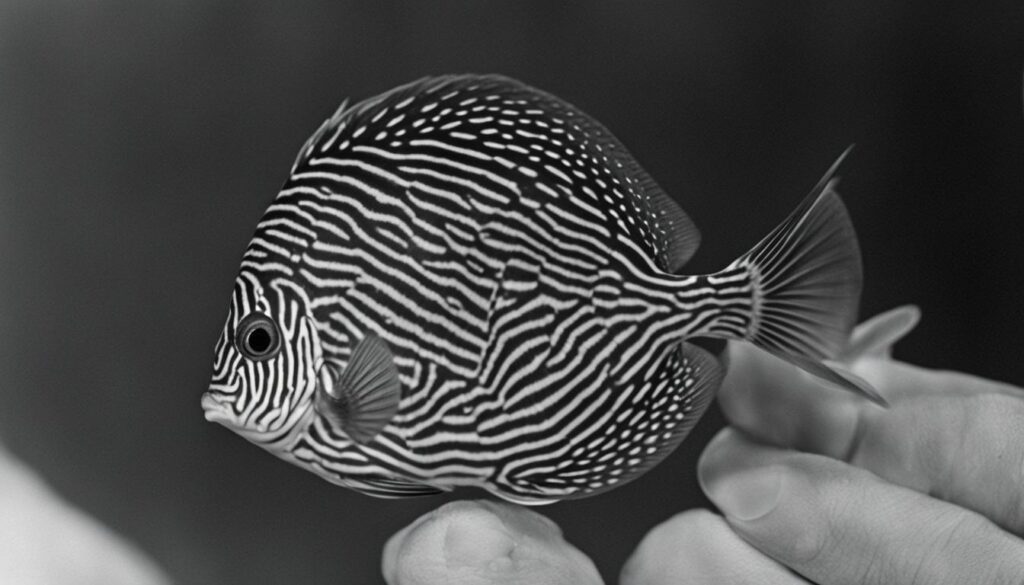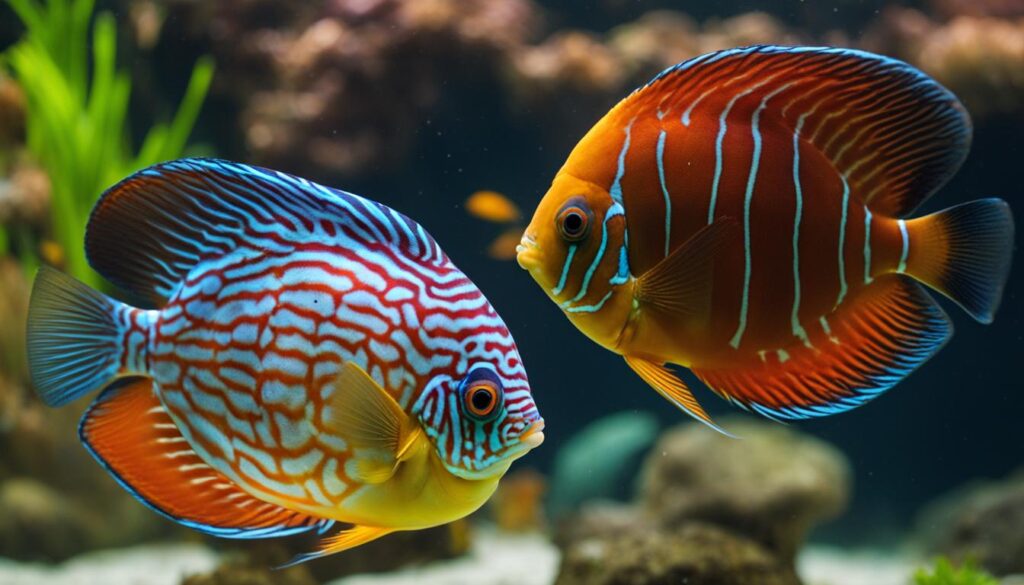How to Sex Discus Fish? As a passionate hobbyist, I know that identifying the gender of discus fish can be a challenge. Whether you’re a beginner or an experienced keeper, it’s essential to understand the sexing techniques to ensure the health and happiness of your fish.
In this comprehensive guide, I will provide tips and tricks on how to sex discus fish. You’ll learn about the different visual cues, behavior patterns, and physical differences between male and female discus fish. From examining coloration patterns to genetic testing, you’ll discover the best sexing techniques to identify your discus fish’s gender accurately.
Table of Contents
Key Takeaways:
- Sexing discus fish is essential for determining the gender of your fish accurately.
- Visual cues, behavior, coloration patterns, size, and fin differences are all factors to consider when sexing discus fish.
- Genetic testing can provide a definitive method for identifying discus fish gender.
- Troubleshooting common challenges can help you overcome difficulties when sexing discus fish.
- Expert tips and tricks can improve your ability to sex discus fish with confidence.
How to Sex Discus Fish?: Understanding Discus Fish Anatomy
Discus fish are one of the most strikingly beautiful species of freshwater fish. Before we learn how to sex discus fish, it’s essential to understand some basic anatomical differences between males and females.
The first notable distinction is the shape of the genital papilla, which is a small protrusion located in front of the anal fin. In males, this papilla is thin and pointed, while females will have a more rounded and thicker papilla.
Another difference between males and females is their body shape. Males will have a more streamlined and elongated profile, while females will have a rounder and fuller body.
Males and females will also have different fin lengths, with males typically having longer dorsal and anal fins. Females, on the other hand, will have shorter but wider fins.
By recognizing these distinctions, you’ll be in a better position to identify the gender of your discus fish accurately. However, it’s important to note that these characteristics may not always be apparent or definitive, so be sure to take multiple factors into account when determining your fish’s gender.
Male and Female Discus Fish Anatomy Comparison Table
| Anatomical Feature | Male Discus Fish | Female Discus Fish |
|---|---|---|
| Genital Papilla | Thin and pointed | Rounded and thicker |
| Body Shape | Streamlined and elongated | Rounder and fuller |
| Fin Length | Longer dorsal and anal fins | Shorter but wider fins |
Visual Clues for Sexing Discus Fish
When it comes to determining the gender of your discus fish, visual observations are an essential aspect. Discus fish display various physical characteristics that can help you distinguish between a male and a female. In this section, I’ll be discussing some of the most common visual clues to help you correctly identify the gender of your discus fish.
Body Shape and Size
Male and female discus fish have different body shapes and sizes that you can use to your advantage when trying to identify their gender. Males are usually larger and have a rounder and more muscular body shape, while females are smaller and have a more streamlined and slender shape.
Dorsal Fin
The dorsal fin is another crucial factor to consider when sexing discus fish. In males, the fin is generally longer and more pointed, and they have a more prominent bump on their forehead known as the nuchal hump. The dorsal fin of females is shorter and more rounded, and they lack the nuchal hump.
Anal Fin
The anal fin can also provide valuable clues for identifying the gender of your discus fish. In males, the anal fin has a more pointed and elongated shape, while females have a shorter and rounder fin.
Behavior
Pay close attention to the behavior of your discus fish. Males tend to be more aggressive during breeding and may display courting behavior, such as spiral swimming and flaring their fins. Females may show interest by shaking and quivering their bodies and will be more reserved and relaxed when not breeding.
By observing and combining these visual clues, you can accurately sex your discus fish and keep a better track of their breeding. However, it’s essential to remember that some variations may exist even within males or females, and none of these visual cues are 100% reliable alone. Therefore, using multiple methods, including examining the size, fins, coloration, and behavior, is crucial for accurate gender identification.
Behavioral Differences Between Male and Female Discus Fish
Observing the behavior of discus fish can be a valuable tool in determining their gender. Male and female discus fish display distinct behaviors during breeding and courtship that can provide insight into their gender.
Male discus fish are typically more territorial and aggressive during the breeding process, while females tend to be more docile and nurturing. Males may exhibit behavior such as circling around the female, darting towards her, and flaring their fins to attract her attention. Females, on the other hand, may stay close to a breeding site and make rhythmic movements to clean and prepare the area for spawning.
By carefully observing your discus fish’s behavior, you can gain a better understanding of their gender and breeding habits. If you plan on breeding discus fish, it’s crucial to pay close attention to their behavior to ensure a successful mating process.
One helpful tip to observe their behavior is to keep a journal or log of their activities and interactions. By recording their behavior over time, you can identify patterns and make more informed judgments about their gender.
Remember to be patient when observing your discus fish, as it may take time to recognize distinct behavior and habits. By combining knowledge of behavior with other techniques, such as visual cues and size and fin differences, you can confidently determine the gender of your discus fish.
Examining Coloration Patterns
When it comes to discus fish gender identification, analyzing their coloration patterns is an essential technique used by many hobbyists. Differences in coloration between male and female discus can indicate their gender accurately and provide valuable insight into their breeding behavior.
How to identify discus fish gender through coloration?
Male discus fish typically display more vibrant and intense colors, especially during the breeding season. Their colors become brighter and more pronounced, especially on their fins. On the other hand, female discus fish are softer and duller in color, displaying more natural hues.
Another critical factor in coloration is the presence of stripes on the discus fish’s body. In general, male discus fish have more stripes than females. Male discus fish may have up to eight stripes, while females typically have fewer stripes or no stripes at all.
Understanding the correct interpretation of coloration patterns
It’s crucial to keep in mind that coloration can be a subjective technique since color intensity can vary based on lighting, water conditions, or stress levels. Therefore, it’s best to observe your discus fish’s coloration patterns over time to make an accurate identification.
Coloration patterns in male and female discus fish
| Coloration | Male Discus Fish | Female Discus Fish |
|---|---|---|
| Vibrancy and intensity | Bright and intense | Softer and duller |
| Fin colors | Pronounced | Natural hues |
| Body stripes | More common; up to 8 stripes | Fewer stripes or no stripes |
By analyzing coloration patterns in discus fish, hobbyists can develop a better understanding of their gender, breeding behavior, and overall health. Nonetheless, it’s essential to use coloration as one factor among many to determine the gender of your discus fish correctly. While coloration patterns are a useful tool, it’s crucial to combine other methods, such as venting and observation of behavior, for an accurate determination.
Size and Fin Differences
Aside from visual traits, other physical characteristics, such as size and fin differences, can provide crucial insights into the gender of discus fish. Comparing physical features between male and female discus fish can enhance your ability to determine their gender accurately.
Generally, male discus fish are slightly larger than females. Males can grow up to 8-10 inches, while females are slightly smaller, growing only up to 7-9 inches. Take note that growth rates and sizes can still vary depending on their diet, tank conditions, and genetic traits.
Another notable way to distinguish their gender is through their fin shape. Male discus fish typically have longer and more pointy dorsal fins, whereas females’ dorsal fins are shorter and rounded. The anal fins of male discus fish also tend to taper at the ends, whereas females have anal fins that are more rounded.
Size and Fin Differences Comparison Table
| Male Discus Fish | Female Discus Fish | |
|---|---|---|
| Size (inches) | 8-10 inches | 7-9 inches |
| Dorsal Fin | Longer and pointy | Shorter and rounded |
| Anal Fin | Tapered at ends | Rounded |
Keep in mind that discerning the gender of juvenile discus fish can be challenging, as physical differences may not yet be evident. It is best to wait until they reach sexual maturity, around 10-12 months, before attempting to sex them.
With these important tips to consider, you’ll be on your way to accurately determining the gender of your discus fish.
Venting Technique for Sexing Discus Fish
When other sexing methods don’t suffice, experienced hobbyists and breeders often turn to venting as a reliable technique. Venting involves using a flashlight to examine the genital papilla of the discus fish. By analyzing the shape and size of this area, you can determine the gender of the fish accurately.
However, it’s crucial to note that venting should only be attempted by experienced individuals. Incorrectly performing this technique can harm the fish and potentially lead to death. It’s recommended to seek guidance from a professional before attempting to vent your discus fish.
Here’s a brief guide to help you understand the venting process:
- Choose a mature and healthy fish: Select a discus fish that has reached sexual maturity and is free from any health issues.
- Prepare the equipment: Gather a high-quality flashlight and a clean, white background surface.
- Sedate the fish: To minimize stress and discomfort to the fish, you can use clove oil or other sedatives. Administer the sedative according to the manufacturer’s instructions.
- Flip the fish: Gently turn the fish over so that its belly faces upward.
- Shine the flashlight: Use the flashlight to illuminate the genital area of the fish. The genital papilla is located just behind the end of the fish’s anal fin, and its shape and color can indicate the sex of the fish.
- Compare the results: Observe the shape and size of the genital papilla and compare it to reference images of male and female genitalia.
It’s essential to remember that venting should only be considered as a last resort, and it’s crucial to seek professional guidance before attempting it.

Genetic Testing for Discus Fish Gender Determination
If you want a more definitive method to determine the gender of your discus fish, genetic testing can be an option. This method involves analyzing the DNA of your fish to identify its sex.
Determining discus fish gender with genetic testing can provide a higher level of accuracy compared to other methods, but it can be more expensive and time-consuming.
There are several benefits to genetic testing, including:
- Accurate identification of the fish’s sex
- Elimination of the need to wait for the fish to mature or breed
- Reduced risk of misidentifying the gender, which can lead to unsuccessful breeding attempts
However, there are also some drawbacks to genetic testing, such as:
- Higher costs compared to other sexing methods
- Difficulty in finding laboratories that specialize in genetic testing for discus fish
- Risk of injury or stress to the fish during the testing process
Despite its disadvantages, genetic testing can be considered as a useful tool for discus fish enthusiasts who want to ensure the accurate identification of their fish’s gender.
| Pros | Cons |
|---|---|
| Accurate identification of the fish’s sex | Higher costs compared to other sexing methods |
| Elimination of the need to wait for the fish to mature or breed | Difficulty in finding laboratories that specialize in genetic testing for discus fish |
| Reduced risk of misidentifying the gender, which can lead to unsuccessful breeding attempts | Risk of injury or stress to the fish during the testing process |
Ultimately, whether you choose to use genetic testing or other methods, having a clear understanding of the gender of your discus fish is crucial in ensuring their proper care and successful breeding.
Expert Tips for Sexing Discus Fish
Sexing discus fish can be challenging, even for experienced hobbyists. But fear not! I have gathered some expert tips to help you improve your ability to identify the gender of your discus fish accurately.
Tip 1: Observe Consistently
Observation is the key to accurate sexing. You need to observe your discus fish consistently for behavioral differences, size, and coloration patterns that can help you determine their gender. Males tend to be more aggressive during breeding and courtship, while females are more passive and reserved.
Tip 2: Know the Breed
Understanding the specific breed of your discus fish can help you better differentiate between male and female. Some breeds have more distinctive characteristics than others, so research the breed to which your discus fish belongs to enhance your sexing abilities.
Tip 3: Check the Genital Papilla
If you’re comfortable checking your fish’s genital papilla, this can be a reliable technique to determine their gender. Female discus fish have a shorter, rounder papilla, while males have a longer and more pointed one.
| Sex | Genital Papilla |
|---|---|
| Male | Long and pointed |
| Female | Short and round |
Tip 4: Look at the Breeding Tube
The breeding tube is a small protrusion on the ventral side of discus fish, and it’s more prominent in males. Males use this tube to fertilize eggs during breeding, and the length of the breeding tube can help you determine the gender of your discus fish.
Tip 5: Seek Expert Advice
If you’re still struggling to identify the gender of your discus fish, don’t hesitate to seek expert advice. Local fish stores or experienced hobbyists can offer valuable insights to help you enhance your sexing skills.

Troubleshooting Common Challenges in Sexing Discus Fish
As with any skill, sexing discus fish requires practice and patience. Sometimes, even the most experienced hobbyists encounter roadblocks that make it difficult to determine the gender of their discus fish. Whether you’re struggling with distinguishing between color variations or finding it hard to detect behavioral differences, we’ve got you covered. Here are solutions to overcome common challenges encountered during the gender identification process:
1. Coloration Patterns Not Clear
If you are having difficulty interpreting coloration patterns, there are a few solutions to consider:
- Observe the fish for a more extended period as colors can change over time.
- Position the fish under different lighting conditions to enhance color differences.
- Compare coloration between multiple discus fish for a broader perspective.
2. Size and Fin Differences Not Pronounced
If you’re finding it hard to differentiate size or fin differences amongst your discus fish, try these steps:
- Position the fish under different lighting conditions to improve visibility.
- Compare the physical characteristics of multiple discus fish at once.
- Consult vetted online resources to help you understand the differences between male and female discus fish.
3. Venting Technique Not Successful
Venting discus fish is a technique used to examine the genitalia for gender identification. While it is considered the most definitive method, it can be challenging and carries risk. Here are some tips:
- Practice with non-breeding adults to build confidence and skill.
- Use a sterilized venting needle to minimize infection risk.
- Seek expert advice before venting to avoid damaging the fish.
Remember, even experienced hobbyists face challenges when sexing discus fish, so don’t be discouraged if you encounter difficulties. By following these solutions and persisting in your efforts, you can refine your skills and confidently determine the gender of your discus fish.
My Experience with Sexing Discus Fish
As an experienced hobbyist, I’ve sexed my fair share of discus fish over the years. It’s a rewarding feeling to accurately determine the gender of your fish and gain a deeper understanding of their behavior and needs.
Through trial and error, I’ve developed a few sexing discus fish techniques that have proven to be reliable and effective. One approach that I prefer to use is observing their behavior during breeding and courtship. Males tend to display more aggressive behavior, while females are more passive.
Another method I use is examining the size and fin differences between males and females. Males are typically larger and have longer, pointed dorsal fins, while females are smaller and have shorter, rounded dorsal fins.
Of course, each fish is unique and may not adhere to these generalizations, so it’s essential to consider a combination of visual cues, behavior, coloration, size, and fin differences to ensure accurate sexing.
Ultimately, mastering how to sex discus fish comes with practice and experience. Don’t get discouraged if you encounter challenges along the way. Troubleshoot the issues and try different techniques until you find what works for you.
Remember to have fun and enjoy the process. Discus fishkeeping is a rewarding hobby that can bring years of joy and fulfillment. Happy sexing!
SEO Keywords: how to sex discus fish, sexing discus fish techniques
FAQ
How do I sex discus fish?
Sexing discus fish can be challenging, but there are several techniques you can use. Some of these include observing visual clues such as coloration and size differences, paying attention to behavioral differences, and using techniques like venting or genetic testing.
What are the key differences between male and female discus fish?
Male discus fish often have more vibrant colors, larger fins, and a more streamlined body shape. Females, on the other hand, tend to have rounder bodies and may exhibit less intense coloration and smaller fins.
Are there any visual cues that can help me identify the gender of my discus fish?
Yes, there are several visual cues to look out for. Males may have brighter colors and longer fins, while females may appear rounder and have less intense coloration. Additionally, examining the size and shape of their genital papillae can provide further clues.
Do male and female discus fish exhibit different behaviors?
Yes, male and female discus fish may display distinct behaviors during breeding and courtship. Males may chase females, display courtship rituals, and be more territorial. Females may show less aggressive behavior and may be observed cleaning potential breeding sites.
Can discus fish coloration patterns indicate their gender?
Yes, coloration patterns can provide valuable clues about the gender of discus fish. Males often display more vibrant and intense colors, while females may have more subdued or pale hues. However, it is important to note that coloration alone may not be a definitive indicator of gender.
Are there any differences in size and fin characteristics between male and female discus fish?
Yes, size and fin differences can help in determining the gender of discus fish. Male discus fish generally grow larger and have longer fins compared to females. By comparing the physical characteristics, you can gain insights into the gender of your discus fish.
What is venting, and how can it be used to sex discus fish?
Venting is a technique used by experienced hobbyists and breeders to determine the gender of discus fish. It involves gently squeezing the fish near the vent area to observe the shape and position of the genital papillae. Venting should only be performed by knowledgeable individuals as it requires proper handling skills.
Is genetic testing available to determine the gender of discus fish?
Yes, genetic testing can be an option for those seeking a more definitive method of sexing discus fish. However, it is not widely available and may require specialized testing facilities. Genetic testing involves analyzing the fish’s DNA to identify its gender accurately.
Any expert tips for improving my ability to sex discus fish?
Yes, there are a few expert tips you can follow. Firstly, familiarize yourself with the specific characteristics and traits of male and female discus fish. Secondly, observe your fish closely and make notes of any distinct behaviors or physical features. Lastly, consult with experienced discus fish keepers or breeders for guidance and insights.
What common challenges may arise when sexing discus fish, and how can I overcome them?
Sexing discus fish can be challenging, especially for beginners. Some common challenges include the fish’s young age or size, as well as variations in coloration within certain strains. To overcome these challenges, it is important to be patient and observe the fish over time, considering multiple indicators such as behavior, size, fin characteristics, and venting.
References
The International Discus Association (IDA)
The Discus World International (DWI)
The South American Cichlid Association (SACA)
The American Cichlid Association (ACA)
Please check other articles on this website like:
Master Breeding Techniques for Angelfish – A Guide for Hobbyists
Mastering Dwarf Puffer Fish Care: A Friendly Guide
Male or Female Betta? How to Tell – Your Ultimate Guide
Complete Guide to Plecostomus Tank Size: Tips and Advice
Simple Guide to Easy-to-Care-for Aquarium Plants
Discover the Diverse Corydoras Catfish Varieties- A Guide
Get to Know Various Types of Algae Eaters
Master Guide: Best Water Parameters for Goldfish Care 2023-24
Mastering Black Ghost Knife Fish Care: A Comprehensive Guide
Optimal pH Levels for Tropical Fish: Essential Aquarium Guide
Discovering Freshwater Snail Species: An In-depth Guide
Expert Tips for Breeding Guppies: Keys to Successful Fishkeeping
Discover Peaceful Community Fish: Your Guide to Calm Aquatics
Ultimate Guide to Live Food for Betta Fish — Healthy Choices
Complete Guide to Your Perfect Cichlid Tank Setup
Your Guide to the Best Substrate for Planted Aquariums
Essential Guide to Discus Fish Care: Help Your Pets Thrive!
Grow Your Own Eden: Beginner-Friendly Aquascaping Plants Guide
Perfect Neon Tetra Tank Mates: Guide to Aquarium Harmony
Product Review of Eheim Classic vs Professional
The Ultimate Guide to Discus Fish Care
What Fish Can Live With Discus?
Ideal pH for Discus Fish | Aquarium Water Guide









